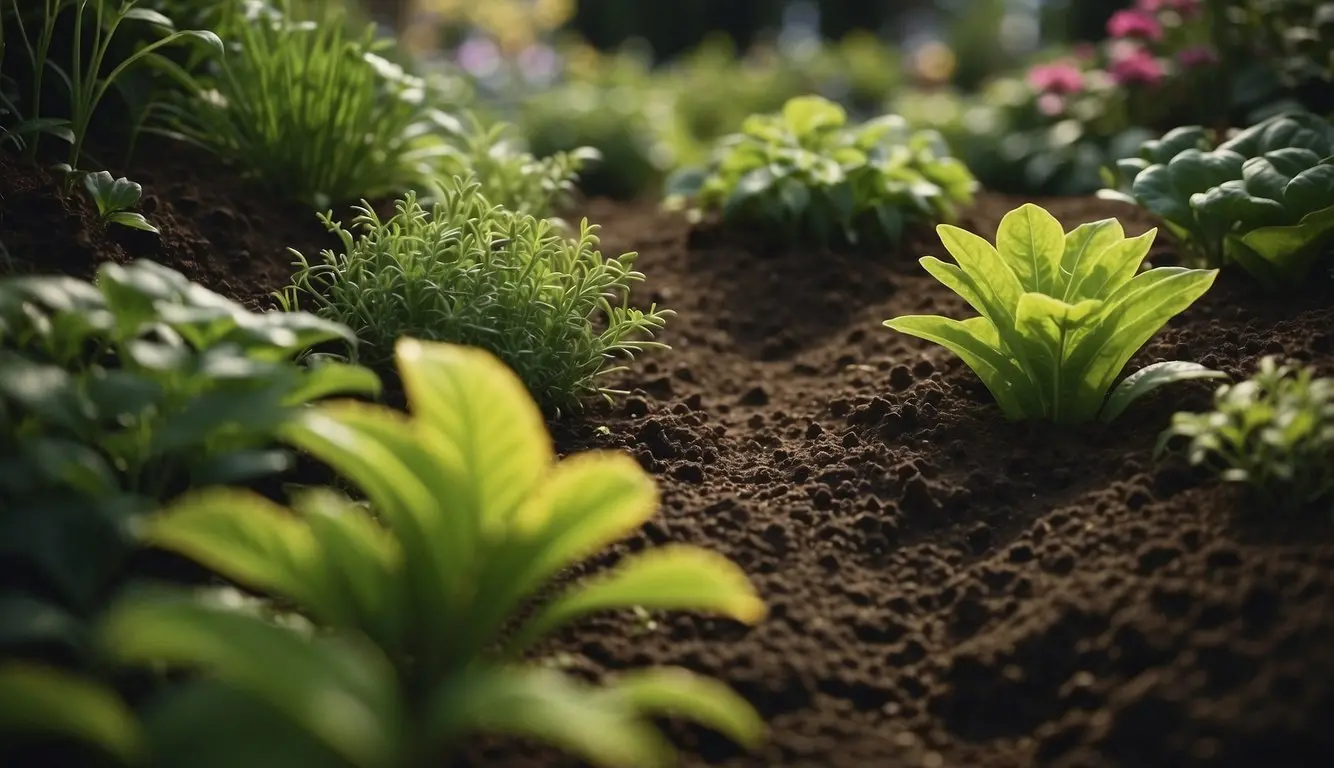If you love the idea of a beautiful garden but don’t have the time or energy for high maintenance, pest-ridden plants, then a low maintenance pest-resistant garden design is the perfect solution for you. A garden that is easy to maintain, pest-resistant, and beautiful is not only possible but also practical. In this article, you will learn how to design a garden that requires minimal upkeep and is resistant to pests.

Understanding Pest-Resistant Gardens is the first step in designing a low maintenance garden. You need to know which plants are naturally resistant to pests and diseases. Designing for Low Maintenance is the second step. You need to choose plants that require minimal watering, fertilization, and pruning. Selecting the Right Plants, Soil Health and Fertility, Irrigation and Water Management, Garden Layout and Plant Spacing, and Natural Pest Control Methods are all important factors to consider when designing a low maintenance, pest-resistant garden.
Key Takeaways
- A low-maintenance, pest-resistant garden is practical and easy to design.
- Understanding which plants are naturally resistant to pests and diseases is the first step in designing a low-maintenance garden.
- Selecting the right plants, soil health and fertility, irrigation and water management, garden layout and plant spacing, and natural pest control methods are all important factors to consider when designing a low-maintenance, pest-resistant garden.
Table of Contents
Understanding Pest-Resistant Gardens
If you’re tired of dealing with pests in your garden, then a pest-resistant garden may be the solution you’re looking for. Pest-resistant gardens are designed to minimize pest damage and reduce the need for chemical pesticides. In this section, we’ll discuss the benefits of pest-resistant gardens and key concepts in pest resistance.
Benefits of Pest-Resistant Gardens
Pest-resistant gardens offer a range of benefits, including:
- Reduced pesticide use: By designing your garden to be pest-resistant, you can reduce your reliance on chemical pesticides. This can help to protect the environment and reduce your exposure to harmful chemicals.
- Lower maintenance: Pest-resistant gardens are often easier to maintain than traditional gardens. By selecting plants that are naturally resistant to pests, you can reduce the amount of time and effort required to keep your garden healthy.
- Increased biodiversity: By designing your garden to be pest-resistant, you can encourage a wider range of beneficial insects and other wildlife to visit your garden. This can help to create a more diverse and resilient ecosystem.
Key Concepts in Pest Resistance
To create a pest-resistant garden, it’s important to understand some key concepts in pest resistance. These include:
- Plant selection: Choosing the right plants is crucial for creating a pest-resistant garden. Look for plants that are naturally resistant to pests, or that have been bred to be resistant. Some examples of pest-resistant plants include marigolds, lavender, and chrysanthemums.
- Companion planting: Companion planting involves planting different types of plants together to create a mutually beneficial relationship. For example, planting garlic and onions alongside tomatoes can help to repel pests that are attracted to the tomatoes.
- Soil health: Healthy soil is essential for creating a pest-resistant garden. By maintaining a healthy balance of nutrients and microorganisms in your soil, you can help to create a strong and resilient ecosystem that is less susceptible to pest damage.
By incorporating these concepts into your garden design, you can create a beautiful and low-maintenance garden that is resistant to pests and other environmental stressors.
Designing for Low Maintenance
Creating a low-maintenance garden is all about designing with intention. By making smart choices, you can reduce the amount of time and effort required to maintain your garden while still enjoying a beautiful and productive space. Here are some principles to keep in mind when designing for low maintenance:
Principles of Low Maintenance Design
- Choose the right plants. One of the most important factors in creating a low-maintenance garden is selecting plants that are well-suited to your climate, soil, and light conditions. Native plants are often a good choice, as they are adapted to your region and require less water and maintenance than non-native species. Look for plants that are disease-resistant and pest-resistant, as this will reduce the need for chemical treatments.
- Group plants by water needs. To reduce water usage and simplify irrigation, group plants with similar water requirements together. This will help you avoid overwatering or underwatering certain plants, and make it easier to maintain a consistent moisture level in the soil.
- Use mulch. Mulch is a great way to suppress weeds, retain moisture in the soil, and regulate soil temperature. Choose a natural, organic mulch like wood chips or shredded leaves, and apply it to a depth of 2-3 inches around your plants. This will help to reduce the need for watering and weeding.
- Minimize lawn areas. Lawns are one of the most high-maintenance features of a garden, requiring frequent mowing, fertilizing, and watering. Consider reducing the size of your lawn or replacing it with low-maintenance groundcovers, shrubs, or perennials.
Incorporating Permaculture Techniques
Permaculture is a design philosophy that emphasizes sustainability, self-sufficiency, and working with nature rather than against it. By incorporating permaculture techniques into your garden design, you can create a low-maintenance, pest-resistant garden that is both productive and beautiful. Here are some permaculture techniques to consider:
- Companion planting. Companion planting is the practice of planting different species of plants together in order to benefit each other. For example, planting marigolds alongside tomatoes can help to repel pests and improve soil fertility.
- Vertical gardening. Vertical gardening involves growing plants on trellises, walls, or other vertical structures. This can help to maximize space, reduce the need for watering and weeding, and provide habitat for beneficial insects.
- Rainwater harvesting. Collecting rainwater in barrels or other containers is a great way to reduce your water usage and provide a free source of irrigation for your garden. Use a simple gravity-fed system to distribute the water to your plants.
By following these principles and incorporating permaculture techniques into your garden design, you can create a low-maintenance, pest-resistant garden that requires less time and effort to maintain.
Selecting the Right Plants
When it comes to creating a low-maintenance, pest-resistant garden, selecting the right plants is key. By choosing plants that are native to your area and drought-tolerant, you can reduce the amount of maintenance required to keep your garden healthy and beautiful.
Native Plants for Pest Resistance
Native plants are well-adapted to the local climate and soil conditions, making them more resistant to pests and diseases. They also require less water and fertilizer than non-native plants, which means less maintenance for you.
Some examples of native plants that are pest-resistant include:
- Coreopsis: These bright yellow flowers are a favorite of butterflies and bees, but are less attractive to pests like aphids and spider mites.
- Yarrow: Yarrow is a hardy perennial that is resistant to many common garden pests, including aphids, spider mites, and thrips.
- Autumn Joy Sedum: This succulent perennial is resistant to deer and rabbits, and is also drought-tolerant.
Drought-Tolerant Varieties
Choosing plants that are adapted to drought conditions is another key to creating a low maintenance garden. Drought-tolerant plants require less water and are less susceptible to pests and diseases.
Some examples of drought-tolerant plants include:
- Lavender: Lavender is a fragrant, drought-tolerant plant that is resistant to deer and many common garden pests.
- Succulents: Succulents like cacti and agave are extremely drought-tolerant and require very little maintenance.
- Russian Sage: This hardy perennial is resistant to deer and pests like aphids and spider mites, and is also drought-tolerant.
By selecting the right plants for your low-maintenance, pest-resistant garden, you can reduce the amount of time and effort required to keep your garden looking its best.
Soil Health and Fertility

Maintaining healthy soil is essential for a low-maintenance pest-resistant garden. Healthy soil provides nutrients to plants, promotes root growth, and increases the soil’s ability to retain water. Here are some tips to help improve your soil’s health and fertility.
Organic Soil Amendments
Adding organic matter to your soil is a great way to improve soil health and fertility. Organic matter such as compost, aged manure, and leaf mold can help improve soil structure, increase nutrient availability, and promote beneficial microorganisms. You can add organic matter to your soil by tilling it in or by using it as a top dressing.
Mulching for Weed and Pest Control
Mulching is an effective way to control weeds and pests while also improving soil health. A layer of mulch helps to suppress weeds by blocking sunlight and can also help to retain soil moisture. Additionally, some types of mulch such as cedar chips, pine needles, and eucalyptus leaves have natural pest-repelling properties. Mulch can be made from a variety of materials including wood chips, straw, and grass clippings.
In conclusion, improving your soil’s health and fertility is an essential step in creating a low maintenance pest-resistant garden. By adding organic matter and using mulch, you can help promote healthy plant growth while also reducing the need for pesticides and herbicides.
Irrigation and Water Management
When it comes to low maintenance, pest-resistant garden design, efficient watering systems and rainwater harvesting methods are key. By implementing these practices, you can reduce your water usage and minimize the need for manual watering.
Efficient Watering Systems
One option for efficient watering is a drip irrigation system. This system delivers water directly to the roots of plants, minimizing evaporation and reducing water waste. Drip irrigation systems can be set on a timer to ensure that your plants receive the right amount of water at the right time.
Another option is a soaker hose, which is a porous hose that allows water to seep out slowly and directly into the soil. This method is also efficient and reduces water waste.
Rainwater Harvesting Methods
Rainwater harvesting is the process of collecting and storing rainwater for later use in your garden. This method reduces the amount of water you need to use from your municipal supply and can also help prevent erosion and flooding.
One common method of rainwater harvesting is to install a rain barrel. This is a container that collects rainwater from your roof and gutters. The water can then be used to water your plants.
Another option is to create a rain garden. This is a garden that is designed to capture and filter rainwater runoff from your property. The garden is typically planted with native plants that are adapted to local rainfall patterns and can help prevent erosion and flooding.
By implementing efficient watering systems and rainwater harvesting methods, you can reduce your water usage and create a low-maintenance, pest-resistant garden that thrives with minimal effort on your part.
Garden Layout and Plant Spacing

When it comes to designing a low-maintenance, pest-resistant garden, proper garden layout and plant spacing are essential. Here are some tips to help you get started.
Maximizing Sunlight and Airflow
To maximize sunlight and airflow, it’s important to space your plants properly. If you plant your plants too close together, they will compete for resources and may not get enough sunlight or air. On the other hand, if you space your plants too far apart, you may end up with a lot of bare soil that is susceptible to weed growth.
One strategy is to group plants with similar light and water requirements together. This will help ensure that each plant gets the right amount of sunlight and water. You can also use trellises or stakes to support climbing plants, which will help maximize space and airflow.
Companion Planting Strategies
Companion planting is another strategy that can help you maximize your garden’s pest resistance. Companion planting involves planting different types of plants together that have a mutually beneficial relationship. For example, some plants, such as marigolds, can help repel pests, while others, such as basil, can help attract beneficial insects.
Here are a few companion planting strategies to consider:
- Plant marigolds near your vegetable garden to repel pests.
- Plant basil near your tomatoes to attract beneficial insects.
- Plant beans near your corn to help fix nitrogen in the soil.
By using these companion planting strategies, you can help create a garden that is more resistant to pests and diseases, and that requires less maintenance over time.
Natural Pest Control Methods

When designing a low-maintenance pest-resistant garden, it’s important to consider natural pest control methods. These methods can help you manage garden pests without relying on synthetic chemicals, benefiting both the environment and the health of your plants. Here are two natural pest control methods you can implement in your garden:
Beneficial Insects and Pollinators
Beneficial insects and pollinators can help control pests in your garden. For example, ladybugs are a natural predator of aphids, while bees and butterflies are important pollinators. You can attract beneficial insects and pollinators to your garden by planting native plants and flowers, providing shelter and water sources, and avoiding the use of pesticides.
Barriers and Repellents
Barriers and repellents can also help control pests in your garden. For example, physical barriers such as row covers and netting can prevent insects from accessing your plants. You can also use repellents such as garlic spray or neem oil to repel pests. However, it’s important to note that these methods may not be effective against all pests, and may need to be combined with other natural pest control methods for best results.
By implementing natural pest control methods in your garden, you can create a low maintenance, pest-resistant garden that benefits both your plants and the environment.
Garden Maintenance Routines

Maintaining a low-maintenance pest-resistant garden requires regular monitoring and timely interventions. Here are some essential garden maintenance routines that you can follow to keep your garden healthy and thriving.
Regular Monitoring
Regular monitoring of your garden is essential to identify pest infestations and other problems early on. Check your plants regularly for signs of damage, such as holes in leaves or chewed stems. Keep an eye out for pests, such as aphids, spider mites, and whiteflies, which can quickly multiply and cause significant damage to your plants.
It’s also important to monitor your garden’s soil moisture levels regularly. Overwatering can lead to root rot, while underwatering can cause your plants to wilt and die. Check the soil moisture level by inserting your finger into the soil up to the second knuckle. If the soil feels dry, it’s time to water your plants.
Timely Interventions
If you notice any signs of pest infestations or other problems in your garden, it’s important to take timely interventions to prevent further damage. Here are some common interventions you can take:
- Handpicking: If you notice a small number of pests on your plants, you can handpick them off. Wear gloves and use a bucket of soapy water to dispose of the pests.
- Pruning: If you notice any damaged or diseased plant parts, prune them off immediately. This will prevent the problem from spreading to other parts of the plant or other plants in your garden.
- Natural remedies: There are several natural remedies you can use to control pest infestations in your garden. For example, you can use neem oil, garlic spray, or insecticidal soap to control pests.
- Chemical treatments: If the pest infestation is severe, you may need to use chemical treatments. However, use them sparingly and according to the instructions on the label to avoid harming beneficial insects and other wildlife in your garden.
By following these garden maintenance routines, you can keep your low-maintenance pest-resistant garden healthy and thriving.
Sustainable Gardening Practices

Creating a low maintenance pest-resistant garden design involves sustainable gardening practices that minimize environmental impact and create a harmonious ecosystem. Here are two key practices to consider:
Composting and Waste Reduction
Composting is a great way to reduce waste and create nutrient-rich soil for your garden. You can compost food scraps, yard waste, and other organic materials to create a healthy soil ecosystem that supports plant growth and reduces the need for synthetic fertilizers.
To get started, you’ll need a compost bin or pile, which can be made from a variety of materials such as wood, wire mesh, or plastic. You can also purchase a compost bin from a garden center or online retailer.
Once you have your compost bin, you can start adding organic materials such as fruit and vegetable scraps, coffee grounds, eggshells, and yard waste. Be sure to avoid adding meat, dairy, or oily foods, as they can attract pests and slow down the composting process.
Regularly turning the compost pile and keeping it moist will help speed up the decomposition process and create nutrient-rich compost for your garden.
Biodiversity and Habitat Creation
Biodiversity is essential for a healthy garden ecosystem. By creating a diverse habitat, you can attract beneficial insects and wildlife that help control pests and pollinate plants.
One way to create biodiversity is by planting a variety of native plants that provide food and shelter for wildlife. You can also create habitats for specific species, such as birdhouses for birds or bee hotels for bees.
Another way to promote biodiversity is by avoiding the use of synthetic pesticides and herbicides, which can harm beneficial insects and wildlife. Instead, consider using natural pest control methods such as companion planting, crop rotation, and handpicking pests.
By implementing these sustainable gardening practices, you can create a low maintenance pest-resistant garden design that supports a healthy ecosystem and reduces environmental impact.
Adapting to Climate Conditions

To create a low maintenance and pest-resistant garden, it is essential to adapt to the climate conditions in your area. Extreme weather conditions can damage plants and make them more susceptible to pests and diseases. Here are some tips to help you adapt to climate conditions:
Plant Selection for Extreme Weather
Choosing the right plants for your garden is crucial to ensure that they can withstand extreme weather conditions. Native plants are ideal for low maintenance gardens because they are already adapted to the local climate. They require less water, fertilizer, and pesticides than non-native plants. You can also select plants that are resistant to pests and diseases. For example, marigolds, lavender, and chrysanthemums are natural pest repellents.
Garden Microclimates
Microclimates are small areas within your garden that have different weather conditions than the surrounding areas. By identifying these microclimates, you can select plants that are better suited to the specific conditions. For example, a north-facing wall will provide shade and cooler temperatures, while a south-facing wall will be warmer and sunnier. You can also create microclimates by using shade cloth, windbreaks, or by planting taller plants to provide shade for smaller ones.
Another way to adapt to climate conditions is to use mulch to retain moisture and regulate soil temperature. Organic mulch, such as bark, leaves, or compost, will break down over time and improve soil fertility. Mulch also helps to suppress weeds, which can compete with your plants for nutrients and water.
By adapting to the climate conditions in your area, you can create a low maintenance and pest-resistant garden that will thrive for years to come.
Innovations in Garden Design

Garden design has come a long way in recent years, with new technologies and eco-friendly materials making it easier than ever to create a beautiful, low-maintenance, and pest-resistant garden. Here are some of the latest innovations in garden design that you can incorporate into your own garden:
Smart Gardening Technologies
Smart gardening technologies are revolutionizing the way we care for our gardens. From automatic watering systems to intelligent pest control, these technologies make it easier than ever to keep your garden healthy and thriving.
One example of a smart gardening technology is the use of sensors to monitor soil moisture levels. By using a soil moisture sensor, you can ensure that your plants are getting the right amount of water without wasting water or overwatering your plants. You can also use smart irrigation systems that adjust watering schedules based on weather conditions, saving you time and money.
Another example of a smart gardening technology is the use of intelligent pest control systems. These systems use sensors to detect pests and then release natural predators to control the pest population. This approach is much more effective than traditional pesticides and is also much safer for the environment.
Eco-Friendly Garden Materials
Eco-friendly garden materials are becoming increasingly popular as people become more aware of the impact that traditional gardening materials can have on the environment. These materials are not only better for the environment, but they are also often more durable and cost-effective than traditional materials.
One example of an eco-friendly garden material is recycled plastic lumber. This material is made from recycled plastic and is much more durable than traditional wood lumber. It is also resistant to rot, insects, and UV rays, making it an excellent choice for garden furniture, decking, and fencing.
Another example of an eco-friendly garden material is permeable paving. This type of paving allows water to seep through the surface and into the ground, reducing runoff and helping to prevent erosion. It is also much more visually appealing than traditional concrete or asphalt paving and can be used to create beautiful garden paths and patios.
By incorporating these innovations into your garden design, you can create a beautiful, low-maintenance, and pest-resistant garden that is also eco-friendly and sustainable.
Conclusion

By implementing low maintenance and pest-resistant garden design, you can enjoy a beautiful and thriving garden with minimal effort. Remember to choose plants that are well-suited to your climate and soil type, and to group plants with similar needs together. Incorporating hardscaping elements such as paths, raised beds, and containers can also help reduce maintenance.
To further reduce the risk of pests and diseases, practice good garden hygiene by removing dead plant material and debris, and avoiding overcrowding. Consider using natural pest control methods such as companion planting, beneficial insects, and organic sprays.
Regular maintenance tasks such as watering, weeding, and pruning can be made easier by using the right tools and techniques. For example, using a drip irrigation system can help conserve water and reduce the risk of overwatering, while mulching can help suppress weeds and retain moisture in the soil.
Overall, designing a low maintenance and pest-resistant garden requires careful planning and consideration, but the rewards are well worth the effort. With a little bit of know-how and some careful attention, you can create a beautiful and thriving garden that requires minimal upkeep.
Frequently Asked Questions

What are the best practices for creating a low-maintenance, pest-resistant garden?
To create a low-maintenance, pest-resistant garden, it’s important to start by selecting plants that are well-suited to your local climate and soil type. Consider using native plants, as they tend to be more resistant to pests and diseases. Use organic mulch to keep weeds at bay and to retain moisture in the soil.
Which plants are recommended for a low-maintenance front yard that is also resistant to pests?
Some plants that are recommended for a low-maintenance front yard that is also resistant to pests include lavender, rosemary, marigolds, and petunias. These plants are not only beautiful, but they also repel many common garden pests.
How can one design a beautiful garden that requires minimal upkeep and is pest-resistant?
To design a beautiful garden that requires minimal upkeep and is pest-resistant, start by selecting plants that are well-suited to your local climate and soil type. Use a mix of annuals and perennials, as well as different textures and colors to add interest. Consider using raised beds or containers to make maintenance easier.
What are the top low-maintenance, pest-resistant plants suitable for Florida’s climate?
Some top low-maintenance, pest-resistant plants suitable for Florida’s climate include firebush, Simpson’s stopper, coontie, and muhly grass. These plants are well-suited to Florida’s hot, humid climate and are resistant to many common garden pests.
What strategies can be employed to reduce garden maintenance and enhance pest resistance?
Some strategies that can be employed to reduce garden maintenance and enhance pest resistance include using organic mulch to keep weeds at bay, selecting plants that are well-suited to your local climate and soil type, and using companion planting to repel pests. Consider using raised beds or containers to make maintenance easier.
Can you suggest budget-friendly backyard landscaping ideas that are both low-maintenance and pest-resistant?
Some budget-friendly backyard landscaping ideas that are both low-maintenance and pest-resistant include using native plants, creating a rock garden, and using ground covers such as clover or creeping thyme. These plants require minimal maintenance and are resistant to many common garden pests.
- Best Brush Cutter: Top 5 Models for Lawn Maintenance in 2024 - January 10, 2024
- Protecting Your Garden from Rodent Damage: Tips and Tricks - December 14, 2023
- Small Space Gardening: Transform Your Garden with Raised Beds - December 10, 2023
